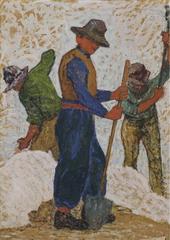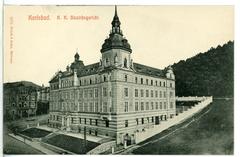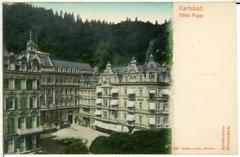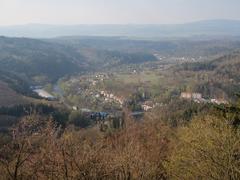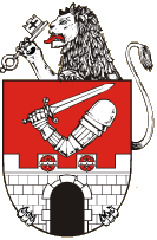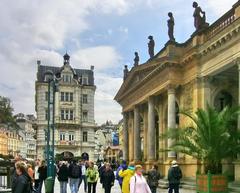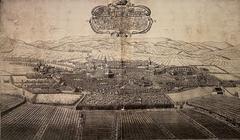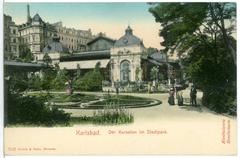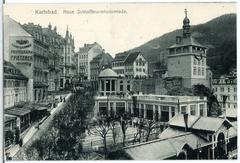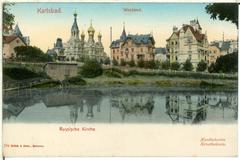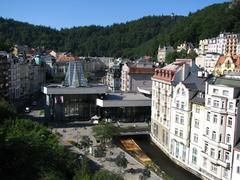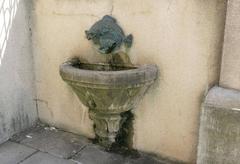Bývalé Policejní Komisařství Karlovy Vary: Visiting Hours, Tickets, and Historical Significance
Date: 04/07/2025
Introduction
Located in the heart of Karlovy Vary, the Bývalé Policejní Komisařství (Former Police Commissariat) is a site deeply entwined with the city’s civic and political history. Although the original building was demolished in 2020, its story remains integral to understanding Karlovy Vary’s evolution from a medieval spa town to a cosmopolitan 20th-century city. This guide provides a comprehensive overview of the commissariat’s history, its architectural and cultural importance, practical visitor information, and recommended nearby attractions.
Historical Background
Evolution of Policing in Karlovy Vary
Karlovy Vary’s reputation as a spa destination dates back to the 14th century, necessitating systems of public order as the town attracted European nobility and visitors (Karlovy Vary History). Early policing was informal, relying on town guards and watchmen. By the late 19th and early 20th centuries, as tourism boomed, the city modernized its police force, leading to the establishment of a dedicated commissariat.
The Bývalé Policejní Komisařství became the headquarters for local law enforcement, reflecting the city’s modernization and international status. Through the 20th century, the building witnessed multiple regime changes: Austro-Hungarian imperial rule, Nazi occupation (when the building served as Gestapo headquarters), communist state security, and, finally, Czech democratic reforms (Police of the Czech Republic - Wikipedia; Karlovy Vary: Past and Present).
Architectural and Cultural Significance
Design and Urban Impact
The main police commissariat building, constructed between 1936–1937, was located at I. P. Pavlova 1381/26. Designed by architect Karl Riedel in a modernist style, it contrasted with Karlovy Vary’s ornate Baroque and Neo-Renaissance landmarks (cs.wikipedia.org). Its curved street façade and robust architecture projected stability and order, fitting for its administrative function.
Strategically situated between the Main Post Office and the historic Čas cinema, the commissariat stood at the center of city life. The building’s history reflects the turbulent events of the 20th century, including its seizure by German forces in 1938, its wartime use by the Gestapo, and its subsequent role as a state security headquarters during the communist period.
Integration with Spa Culture
Law enforcement played a vital role in upholding the tranquil, safe environment essential for Karlovy Vary’s spa culture and international reputation. The police managed public order during major events like the Karlovy Vary International Film Festival and regulated large crowds during spa seasons (Karlovy Vary International Film Festival).
Visiting the Site Today
Site Status and Accessibility
The original building was demolished in 2020, but the site at I. P. Pavlova 1381/26 remains a point of historical interest. A commemorative marker is planned, and the location is easily accessible within the pedestrian-friendly city center.
- Tickets: No entrance fee is required.
- Visiting Hours: The site can be freely visited at any time.
- Accessibility: The area is suitable for all visitors, though the streets may be cobbled or uneven in places.
Guided and Virtual Tours
While there is no building to enter, the Karlovy Vary Information Centre offers guided walking tours that include the former commissariat as part of a broader historical narrative (Karlovy Vary Tour Guide). Virtual and audio-guided tours are available through the SMARTGUIDE and Audiala apps, providing rich historical and architectural context (SMARTGUIDE app; Audiala app).
Nearby Attractions
Enhance your visit to the former commissariat site by exploring Karlovy Vary’s nearby landmarks:
- Mill Colonnade (Mlýnská kolonáda): A grand neo-Renaissance colonnade, home to several hot springs (thetouristchecklist.com).
- Market Colonnade: A picturesque wooden arcade for relaxing walks and mineral water tastings.
- Grandhotel Pupp: An iconic hotel famed for its spa treatments and as a venue for the Karlovy Vary International Film Festival (myglobalviewpoint.com).
- St. Mary Magdalene Church: A Baroque masterpiece with a notable altar and crypt (laidbacktrip.com).
- Museum Moser: Showcases Bohemian glassmaking, a key aspect of the region’s heritage (thetouristchecklist.com).
Tips for Travelers
- Combine Experiences: Integrate the commissariat site with a walking tour of Karlovy Vary’s historic center.
- Use Audio Guides: Enhance your visit with the Audiala or SMARTGUIDE apps for historical context.
- Plan for Comfort: Wear suitable footwear for cobbled streets.
- Visit in Spring or Autumn: Enjoy fewer crowds and pleasant weather.
- Check Local Listings: For seasonal events, festivals, and up-to-date tour information.
Frequently Asked Questions (FAQs)
Q: Can I visit inside the Bývalé Policejní Komisařství?
A: No, the original building was demolished in 2020. The site can be freely visited from the outside.
Q: Are there guided tours of the site?
A: Yes, local walking tours often include the former site, and apps like SMARTGUIDE and Audiala provide self-guided options.
Q: Is the site accessible?
A: Yes, the location is pedestrian-friendly and accessible, though streets may be uneven.
Q: Do I need a ticket?
A: No ticket is required to visit the site.
Q: Can I take photos?
A: Yes, photographing the area is allowed.
Visuals and Further Resources
High-quality archival photographs and maps are available on Wikimedia Commons (Wikimedia Commons). For interactive experiences, use the SMARTGUIDE and Audiala apps or inquire at the Karlovy Vary Information Centre.
Summary
The Bývalé Policejní Komisařství site in Karlovy Vary stands as a symbol of the city’s resilience and layered history—from imperial governance through wartime trauma to modern democracy. Though the building no longer exists, its legacy is preserved through tours, digital resources, and commemorative efforts. Integrate the site into your exploration of Karlovy Vary’s renowned spa culture, architectural landmarks, and vibrant cultural scene for a truly enriching visit.
